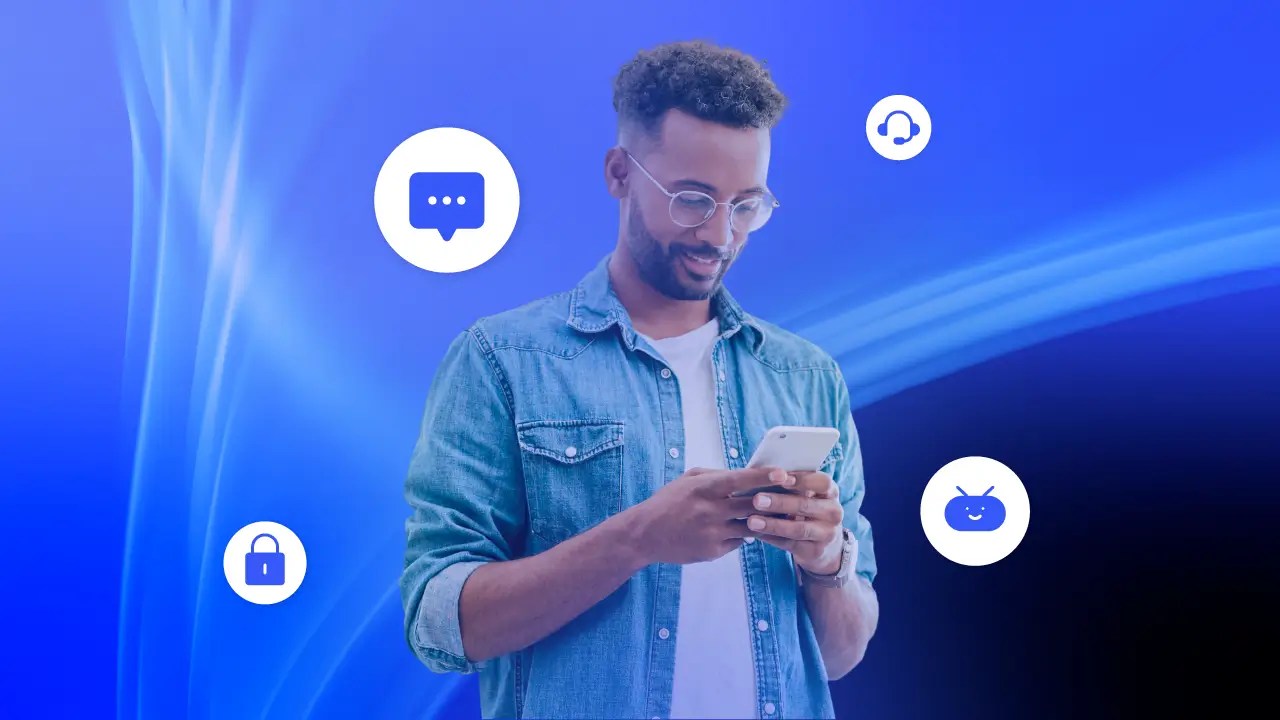Customer service leaders are tasked with the challenge of keeping up with current trends and best practices so that, ideally, their companies exceed expectations. It’s not enough anymore to just have a decent customer service experience — consumers want to be wowed with a great experience.
Businesses can benefit from leveraging new technology to create standout customer experiences, offering faster, more convenient, and more personalized support. Setting up chatbots for customer service purposes can help you do exactly that.
In this post, we’ll discuss common use cases for customer service chatbots and explain how to get started.
Why Use Chatbots for Customer Service?
Chatbots can be used in a live chat widget on a company’s website or mobile app, and they’re incredibly effective at offering customer service functionality. Let’s discuss the benefits of deploying chatbots for customer support.

24/7 availability
Chatbots provide round-the-clock customer support, addressing inquiries and resolving issues outside of traditional business hours. While live agents probably won’t be available at all hours of the day, chatbots can be ready to offer 24/7 customer support for simple questions and concerns, like providing estimated order delivery dates or answering product questions.
Better response times
Customer service expectations are high, with many users wanting more personalized service, a wider variety of response options, and faster response times.
According to data from HubSpot, 90% of consumers rate an “immediate” response as “important” or “very important” if they have a customer service question. The same study found that for many customers, patience caps out at around 10 minutes.

Fortunately, both live chat and chatbots can significantly improve customer service response times. Chatbots can provide immediate interaction options and answer simple questions. This can reduce the overall burden on your customer support agents, freeing them up to respond faster to complex concerns.
Better response times can lead to improved customer relationships, retention, and loyalty.
Related: 6 Best Practices for Implementing a Call Center Chatbot
Scalability
Chatbots can handle multiple consumer interactions simultaneously, helping businesses scale up their customer support almost instantly. This can ensure efficient support even during peak demand periods, with bots acting as a first line of defense for customer support and reducing the number of live agents that may be needed to handle basic customer queries.
Cost-efficiency
AI automation can eliminate repetitive routine tasks and automate workflows to improve the productivity of human agents. This makes it possible for you to optimize labor costs and head count, which can improve resource allocation and actually help your organization save money.
Data collection
Chatbots offer valuable data collection opportunities. The bots gather customer data and insights ranging from qualifying information to purchase intent data, depending on the stage in the customer journey in which they’re used.

You can also learn more about your customer needs and pain points regarding your products, services, and support, which can help you make significant improvements when refining products and customer service processes.
Advanced capabilities
Many live chat services now have chatbots with advanced functionality, which may include the following:
- Natural language processing (NLP): Uses machine learning to help computers understand and communicate in a conversational way.
- Generative AI or conversational AI: Leverages AI technology to create relevant responses based on customer questions.
- Rule-based chatbots: Operate according to strict rules about things like when to use routing to send complex issues to support agents.

Chatbot Use Cases for Customer Service
If you’re wondering how to deploy chatbots for customer service, there are plenty of different use cases that may benefit you.
Frequently asked questions
AI customer service software enables brands to answer common customer requests in real time when customers need help. Support-focused AI bots act as a self-service knowledge base, instantly providing access to product pricing information, account-specific tips, and onboarding guides. Some chatbots can integrate with your helpdesk tools for this purpose.

Order tracking & status updates
Some of the most common questions that customers may have are “When will my order be shipped?” and “When will my refund be processed?” These questions can easily be answered by most AI chatbot software, especially when it’s integrated into your CRM platform. The bots offer customers real-time information on order progress in just a few seconds.
Product information & recommendations
Chatbots can be powerful selling tools for e-commerce businesses. The bots can help customers find the right products as they’re making purchase decisions.

Customers may reach out to find out if an online bakery’s gluten-free products were made in an environment free from cross-contamination or if the business even has any gluten-free items on its menu. The answers could directly impact whether the people making the inquiries decide to purchase anything.
Related: Live Chat Software: Key Features and Examples for Businesses
Returns & exchanges
Many companies have streamlined return and exchange processes. Chatbots can guide customers through these processes, helping them initiate returns, providing instructions on how to return items, processing exchanges, or even explaining standard policies.
A customer may be confused at the beginning of a chat because the online return system won’t work for them. The chatbot could explain that the 30-day return period has timed out but that the customer is still within the 60-day exchange period. The bot could also recommend other products the customer could exchange and help the customer process that exchange during the conversation.
Appointment scheduling
Chatbots can help customers book appointments for everything from a free legal consultation with a local law firm to a sales call with a SaaS company. The bots can recommend time slots based on availability, customer preferences, and the meetings’ purposes.
For example, chatbots for car service centers may know that a tire change only requires a one-hour slot and a several-day-long engine repair requires a drop-off appointment. The bot can recommend available time slots accordingly while ensuring that the right team members will be available to answer questions during those periods.

Billing & payment inquiries
Chatbots can answer customer questions regarding invoices, payments, and account balances. While it’s important to be careful with sensitive customer information, simple user verification can make it possible for bots to handle these queries.
For example, an electric company may help customers quickly assess how much they owe and tell them when their next payments are due. Its chatbots may be able to answer questions about increased monthly fees or missed payments.
Related: 5 Best Chatbots for Lead Generation & Sales
Technical troubleshooting
While some technical issues may be complex and require live agents’ support, many standard issues can be diagnosed and resolved by a chatbot.

For example, SaaS products may use chatbots to guide users through installation and resolve common issues that arise when setting up integrations with third-party tools. The process may be technical enough that customers struggle with it but not so complex or prone to unique errors that it requires a human agent to handle it.
Customer feedback & surveys
Chatbots can gather customer feedback and insights for your support team to assess. The bots can help you learn more about customer preferences and pain points based on the questions that people are asking.
If, for example, customers keep requesting products or services that you don’t yet offer, that’s something to consider. Similarly, consumers may express frustration about your operational policies or your use of a particular invoicing platform. You can take advantage of this information to improve the customer experience.
Proactive customer engagement
You can find new ways to proactively engage customers through the live chat experience. For example, you can offer personalized recommendations and promotions by pulling a customer’s past purchase history from a CRM integration.
You can also run customer success campaigns to preemptively negate potential support needs. When a user is viewing the helpdesk section of your site, your live chat can pop up and ask if the user would like support for a recent purchase.
How to Implement Your Customer Service Chatbot
Ready to offer additional support with a customer service chatbot? There are several best practices to keep in mind.
Creating a Chat Bot with Nextiva Chat – Nextiva Social Media and Reviews
Integrate with existing customer service channels
Choosing chatbot software that integrates with your existing customer service channels and software is important. This ensures a seamless transition between bots and human agents in the same conversation and often streamlines workflows for the support team.
Consider contact center solutions like Nextiva, which allow you to leverage live chat features on your website, mobile app, SMS messaging, and social media platforms like WhatsApp and Facebook Messenger.
Provide clear instructions
When the live chat box pops up, users shouldn’t have any questions about how to get started. Give them guidance on how to interact with the chatbot by providing clear instructions. It can ask users how it can help or provide a list of options like “Ask product question,” “Track my order,” or “Speak to customer support.”
Make sure that there’s always a clear and easy option to escalate the conversation to support reps when necessary. After all, self-service options are great, but sometimes, you need human intervention.
Set proper expectations
A key element of creating an exceptional user experience is setting realistic expectations. Let customers know about the chatbot’s capabilities and limitations. Clearly stating up front what it can and can’t help with can prevent frustration and indicate when users should contact customer service teams instead.
Monitor chatbot performance
Chatbots can provide incredible benefits, but it’s important to monitor how customers use them and how happy customers are with their experiences. You should track key customer service metrics like resolution rate, customer satisfaction rates, and average handling time. It’s also important to look at conversational analytics to fully understand how people are interacting with the bots and where there may be room for improvement.

Review customer interactions
It’s a good idea to collect and analyze customer feedback and data to look for potential improvement opportunities. For example, manual reviews may help you determine that the chatbot waits too long to route customers to a support agent or needs more nuanced information when helping customers with technical problems. Use this information to optimize chatbot performance and the customer experience.
Related: The Newbie’s Guide to Conversational AI Chatbots
Choosing the Best Chatbot for Your Business
Small and medium-sized businesses and enterprise-grade companies alike can benefit from customer service chatbots with advanced capabilities.
Nextiva’s AI-powered chatbot is well suited for businesses of all sizes, offering incredible functionality for both users and customer support teams. It learns from past customer interactions to continually improve service, resulting in lower costs, higher customer satisfaction, and faster responses.

The 24/7 availability can also lead to fewer customer service escalations across all customer service channels, freeing up your support agents to tackle complex issues that actually need their attention. Nextiva’s chatbot helps you deliver an omnichannel experience and create personalized experiences with sales and customer support functionality across your website, mobile app, and social media messaging apps.
And remember, no matter which tool you choose, keep your chatbot accessible for users, be realistic about its limitations, and know when to escalate to human support. When you’re ready to get started, we’re ready to help!
Related: Top Chatbot Providers: Key Features, Uses, & Campaign Ideas

















 Customer Experience
Customer Experience 










